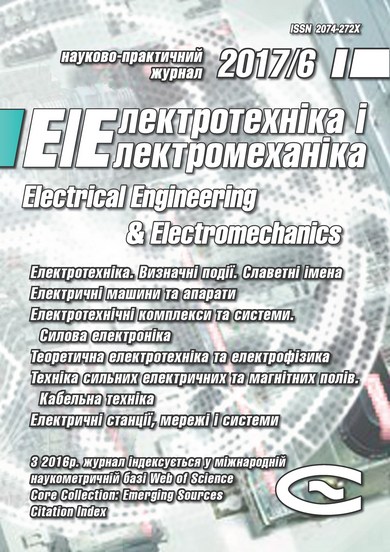DETERMINATION OF RAILWAY ROLLING STOCK OPTIMAL MOVEMENT MODES
DOI:
https://doi.org/10.20998/2074-272X.2017.6.04Keywords:
electromotive railway rolling stock, genetic algorithm, cooling system, traction motor, tramcar, control laws, optimization problem, efficiencyAbstract
Purpose. To develop a methodology for simulating of an electromotive railway rolling stock in terms of power-optimal modes on a track with a given profile and a set motion graph. Methodology. We have used combined genetic algorithm to determine optimum modes of an electromotive railway rolling stock motion: a global search is performed by a genetic algorithm with a one-point crossover and roulette selection. At the final stage of the optimization procedure we have used Nelder-Mead method for the refinement of the optimum. Results. We have obtained that traction motor on a tramcar, while driving on a fixed site, has an excessive power of the cooling system. Its using only in the considered area allows to modernize the cooling system in the way of its power reducing, which in turn provides an opportunity to increase the overall efficiency of the electromotive railway rolling stock. Originality. For the first time, we have obtained the train motion equation in the program-oriented form. This allows to use it for determination of electromotive railway rolling stock optimal control laws according to the Hamilton-Jacobi-Bellman method. Practical value. We have made the computer program to determine optimum modes of an electromotive railway rolling stock motion. The experimental studies of program results for the track section have confirmed the adequacy of the model, which allows to solve the traffic modes optimization problem for the tram track sections and increase the overall efficiency of the electromotive railway rolling stock.References
1. Liubarskiy B.G. Teoretychni osnovy dlya vyboru ta ocinky perspektyvnyh system elektromehanichnogo peretvorennya energiyi elektroruhomogo skladu. Diss. dokt. techn. nauk [The theoretical basis for the selection and evaluation of advanced systems of electromechanical energy conversion of electric rolling stock. Doc. tech. sci. diss.]. Kharkiv, 2014. 368 p. (Ukr).
2. Petrenko O.M., Liubarskiy B.G., Riabov E.S. Investigation of the asynchronous traction motor windings temperature influence on the autonomous inverter voltage operating modes. Electrification of transport, 2016, no.12, pp. 87-91. (Rus).
3. Noskov V.I. Thermal modal traction engine locomotive. Bulletin of NTU «KhPІ», 2012, no.62(968), pp. 142-147. (Rus).
4. Kosmodanianskyi A.S. Teoreticheskie osnovy i razrabotka system regulirovanija temperatury tjagovyh elektricheskih mashin lokomotivov. Diss. dokt. techn. nauk [Theoretical foundations and development of temperature control systems for traction electric cars of locomotives. Doc. tech. sci. diss.]. Мoscow, 2002. 285 p. (Rus).
5. Shcherbatov V.V., Rapoport O.L., Tsukublin A.B. Modeling the thermal state of the traction motor for resource forecasting. Bulletin of the Tomsk Polytechnic University. Geo Assets Engineering, 2005, vol.308, no.7, pp. 156-159. (Rus).
6. Getman G.K. Nauchnye osnovy opredelenija racional'nogo moshhnostnogo rjada tjagovyh sredstv zheleznodorozhnogo transporta [Rolling electrical complex on the basis of the criterion of minimizing the area under the curve of motion]. Dnipro, Dnipro National University of Railway Transport named after academician V. Lazaryan Publ., 2008. 444 p. (Rus).
7. Mokin O.B., Mokin B.I. Modelyuvannya ta optymizaciya ruhu bagatomasovyh elektrychnyh transportnyh zasobiv poverhnyamy zi skladnym relyefom [Modeling and optimization of movement of multi-mass electric vehicles with difficult terrain surfaces]. Vinnitsa, VNTU Publ., 2013. 192 p. (Ukr).
8. DmitrienkoV.D., Zakovorotnyi A.Yu. Modelirovanie i optimizacija processov upravlenija dvizheniem dizel'-poezdov [Modeling and optimization of diesel train trains control processes]. Kharkiv, NTMT Publ. Center, 2013. 248 p. (Rus).
9. Petrenko O.M., Liubarskiy B.G. Determination of the efficiency of the electromotive structure. Key points and approaches. Information and control systems on the railway transport, 2015, no.6, pp. 8-13. (Ukr).
10. Todorov E. Optimal control theory. Bayesian Brain: Probabilistic Approaches to Neural Coding, 2006, chap. 12, pp. 268-298. doi: 10.7551/mitpress/9780262042383.003.0012.
11. Kappen H.J. Optimal control theory and the linear Bellman equation. Bayesian Time Series Models, 2011, pp. 363-387. doi: 10.1017/cbo9780511984679.018.
12. Kanemoto Y. Theories of urban externalities. Holland, North-Holland Publ., 1980. 189 p.
13. Riabov E.S., Petrenko O.M., Overianova L.V. Analysis of losses in the traction induction motor under various power conditions. Eurasian Union of Scientists, 2016, no.12(33), chapt. 2, pp. 59-65. (Rus).
14. SeverinV.P., Nikulina E.N. Metody odnomernogo poiska [Methods of one-dimensional search]. Kharkiv, NTU KhPI Publ., 2013, 124 p. (Rus).
15. Panagiotis G. Study on optimal train movement for minimum energy consumption. Sweden, School of Innovation, Design and Engineering Publ., 2013. 82 p.
16. Balaji M., Kamaraj V. Design of high torque density and low torque ripple switched reluctance machine using genetic algorithm. European Journal of Scientific Research, 2010, vol.47, no.2, pp. 187-196.
17. Petrenko O.M., Domanskyi O.V., Liubarskiy B.G. Method of rolling stock asynchronous traction drive modes optimization. Mechanics and engineer, 2016, no.1, pp. 59-67. (Ukr).
18. Petrenko O.M., Liubarskiy B.G., Gliebova M.L. Software-oriented mathematical model of vehicle movement. Bulletin of NTU «KhPІ», 2016, no.6(1178), pp. 89-95. (Ukr).
19. Owatchaiphong S., Fuengwarodsakul N.H. Multi-objective based optimization for switched reluctance machines using fuzzy and genetic algorithms. 2009 International Conference on Power Electronics and Drive Systems (PEDS). doi: 10.1109/peds.2009.5385926.
Downloads
Published
How to Cite
Issue
Section
License
Copyright (c) 2017 A. N. Petrenko, B. G. Liubarskiy, V. E. Pliugin

This work is licensed under a Creative Commons Attribution-NonCommercial 4.0 International License.
Authors who publish with this journal agree to the following terms:
1. Authors retain copyright and grant the journal right of first publication with the work simultaneously licensed under a Creative Commons Attribution License that allows others to share the work with an acknowledgement of the work's authorship and initial publication in this journal.
2. Authors are able to enter into separate, additional contractual arrangements for the non-exclusive distribution of the journal's published version of the work (e.g., post it to an institutional repository or publish it in a book), with an acknowledgement of its initial publication in this journal.
3. Authors are permitted and encouraged to post their work online (e.g., in institutional repositories or on their website) prior to and during the submission process, as it can lead to productive exchanges, as well as earlier and greater citation of published work.





